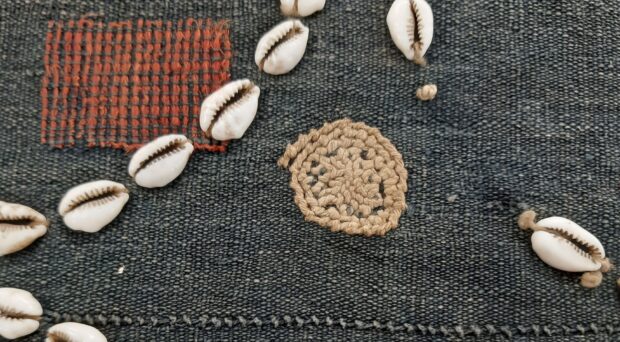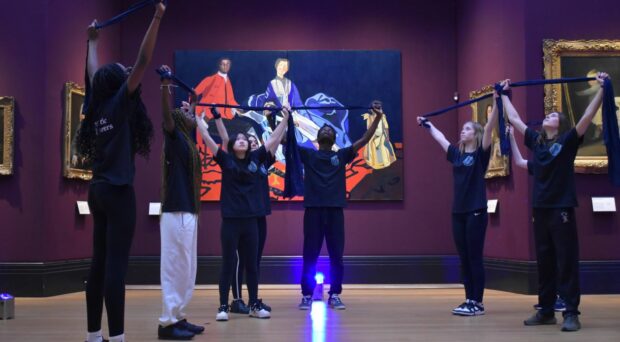The Whipple Museum of the History of Science has begun a refurbishment project to make our Learning Gallery even more fun and family-friendly.
The Learning Gallery is the heart of the Whipple Museum, home to Marcel the anatomical model, charismatic calculators, hands-on activity boxes, and – of course – Whipple icon Mr Froggy. Tucked behind the Main Gallery, this space hosts over 3,000 education visitors a year and rising.
This year, we’re making significant improvements to the fabric of the room and completely refreshing the displays. The project involves every member of the team, with the help of friends from across the University of Cambridge Museums.
What’s it like now?
Currently, the displays include a range of objects and toys used for science learning and large spectacular objects like Mr Froggy, a 1965 electron microprobe, and a myoglobin model. There’s a tantalising glimpse of the Hookham Calculator Collection*, but not enough to satisfy the calculator fanatic (and aren’t we all one of those!).
It’s a hard-working room: our Learning Coordinator, Alison Giles, is teaching in here nearly every day. We also host grown-up talks and seminars in the space, and even the occasional demonstration of a historic scientific experiment. And when things aren’t happening, there’s space for visitors to sit and get hands-on with our selection of handling objects and books.

What do we want to do?
The Learning Gallery project is part of a longer-term plan to enhance our visitor offer at the Whipple. We are committed to developing and diversifying our audience. We know that, at the moment, our weekday opening hours and location within a University building mean we might not be top of families’ ‘to visit’ lists. We’ve introduced regular Saturday openings for the first time – and keep your eyes peeled for a new shop coming soon.
As such, our plans for the space include:
- Making improvements to the fabric of the Gallery, including new lights, the removal of the false ceiling, and the installation of a plinth to protect the large objects on open display
- A complete redisplay, aligning the displays with the Whipple learning programme, and adding more interactive elements
- New furniture, including a cosy corner with a sofa and sensory mat
- A creative installation.
Our goal is that children and young people of all ages, and their families, are able to engage with the history of science in an exciting space that works for them and is intellectually and physically accessible.
Getting inspiration
The team has been on a few fact-finding missions in preparation. We’re so grateful to colleagues at the Grant Museum of Zoology and at the Young V&A for taking the time to show us around their wonderful new spaces.


We’ve also taken inspiration from the Fitzwilliam Museum’s Family Welcome project, the Polar Museum’s beautiful sensory maps, and the Museum of Cambridge’s My Mini Museum project.
Coming up with an approach
Returning to Cambridge full of inspiration, we started to work up our approach to the redisplays. Some of the factors are very practical – some beloved objects, like Marcel, have been on display a long time and need a rest in the stores – and some are experimental.
Alison has integrated new themes into the taught learning programme (such as Science, Exploration and Empire), and we want to represent these in the space, with a dedicated display for each topic. There’s also a chance to try different approaches to the displays, inspired by our friends at the Grant Museum (whisper it: Wall of Calculators…).
We’re aiming to design an interpretation strategy that is accessible to everyone, with layers for different age groups. We ended up giving these froggy names (because of course):
- Tadpoles (early years children): a zone that runs around the lowest level of the gallery with eye-catching objects and text that inspires action for them to enjoy with their grown-ups
- Frogs (primary age children): interpretation that brings in a sense of wow and relates to their lives
- Newts** (older children & grown ups): sign-posting to further information on the objects.
The hope is that the Gallery works horizontally (around the room) as well as vertically (up and down in the cases).
At first glance, scientific instruments might not seem the most obviously accessible of objects. They bring together not just technology and scientific principles that might not be immediately obvious to the casual viewer, but past science too.
But on a second, they’re all about actions: things you can do with the objects. We want to bring in those actions and movement into the new display and encourage visitors to try instruments out themselves in the handling boxes, bringing in multi-sensory elements to the experience.
When it comes to design, we’re working on a colour palette that picks up on some of the retro, spacey Whipple vibes and turns a brown and magnolia space into something fun and colourful, but not overstimulating.
Will this all work? Will the Learning Gallery end up covered in frogs and tadpoles? Luckily, we’ve got help…
Consulting our visitors
Across the summer, we’ll be studying how our visitors use the space, and getting their feedback on a test case.
Our University of Durham Museum Studies student Catriona Higgins has been working with Visitor Assistant Annie James on some light-touch visitor tracking, inspired by the methodology developed by Sarah-Jane Harknett, to understand how visitors are using the space. Catriona and Annie will be seeing how visitors respond to a test case using the draft interpretation strategy and design – come along and see what you think yourself.

Leaning into the fact that the Gallery will be in a pickle transition phase over the summer, the Whipple Summer at the Museums activities will invite young visitors to become museum designers and create their own shoebox galleries. We’re interested to see which objects the designers like the best, and what they think makes a fun and welcoming museum space. A special Museum Designers trail will help capture some of their feedback.
Working in the wow
Our aim is to work with a creative practitioner in the New Year to bring in the wow to the space with something eye-catching and exciting in the ceiling. The Summer activities also give us a chance to find out what families might like to see.
What’s happening now?
Lots! By the end of July, the old ceiling will be down, new plinth installed, and a test case will be ready for review. We’ll keep you posted as things develop… Follow our progress on the Museum’s new Instagram account, @whipplemuseum.

*Did you know that the Whipple holds the most important publicly accessible collection of pocket electronic calculators in the country? Now you do.
**Yes, we know these aren’t the final stage of the frog life cycle, but the pun on Isaac Newton was too irresistible.







